The growing demand for smaller, faster, and more efficient devices has accelerated the adoption of Micro-electromechanical systems (MEMS), also called micromachines (in Japan) or microsystems technology (MST) (in Europe), across industries. The shift toward smart vehicles, wearables, and remote healthcare continues to fuel this technology’s expansion.
The current value of the MEM market is around $17.39 Billion, and it is expected to grow to $31.4 billion by 2031 with a CAGR of 8.8%. This strong growth trajectory is fueled by advancements across segments that define the MEMs industry.
MEMS technology’s primary purpose is to enable the development of highly integrated systems that offer advanced sensing, control, and actuation capabilities while maintaining minimal size and energy consumption. The demand for cost-effective and scalable solutions in high-growth sectors drives innovations in MEMS technology.
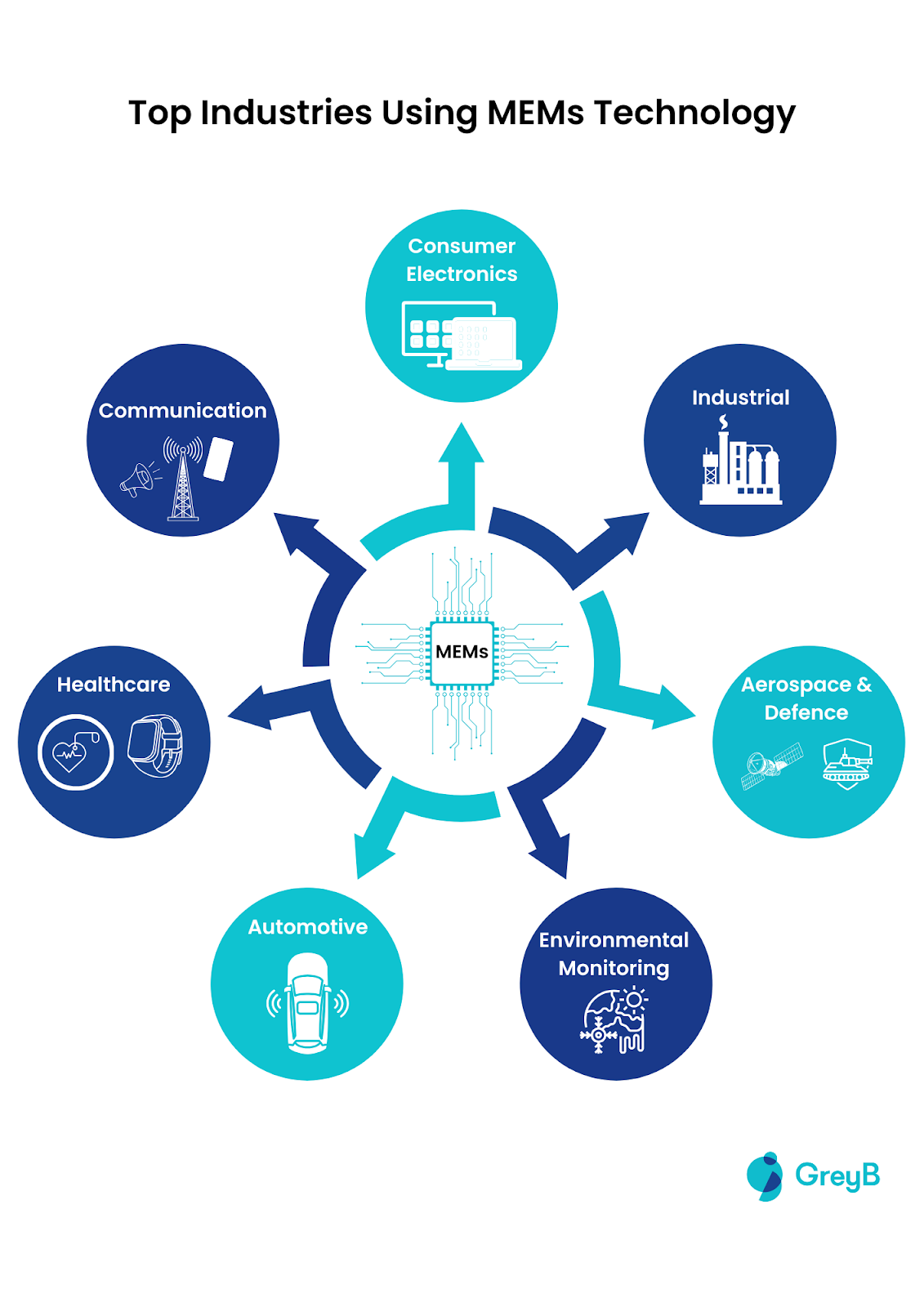
MEM devices have become the backbone of innovation in healthcare and consumer electronics to achieve automation, precision, and efficiency.
But why?
MEM technology integrates electrical and mechanical components at the micro-level, enabling devices to detect, process, and respond to physical stimuli such as pressure, temperature, and motion.
Its dual capability—sensing and actuation—makes MEMs indispensable for applications requiring precision, space efficiency, and accuracy, such as automotive sensors, medical devices, and RF switches in telecommunications.
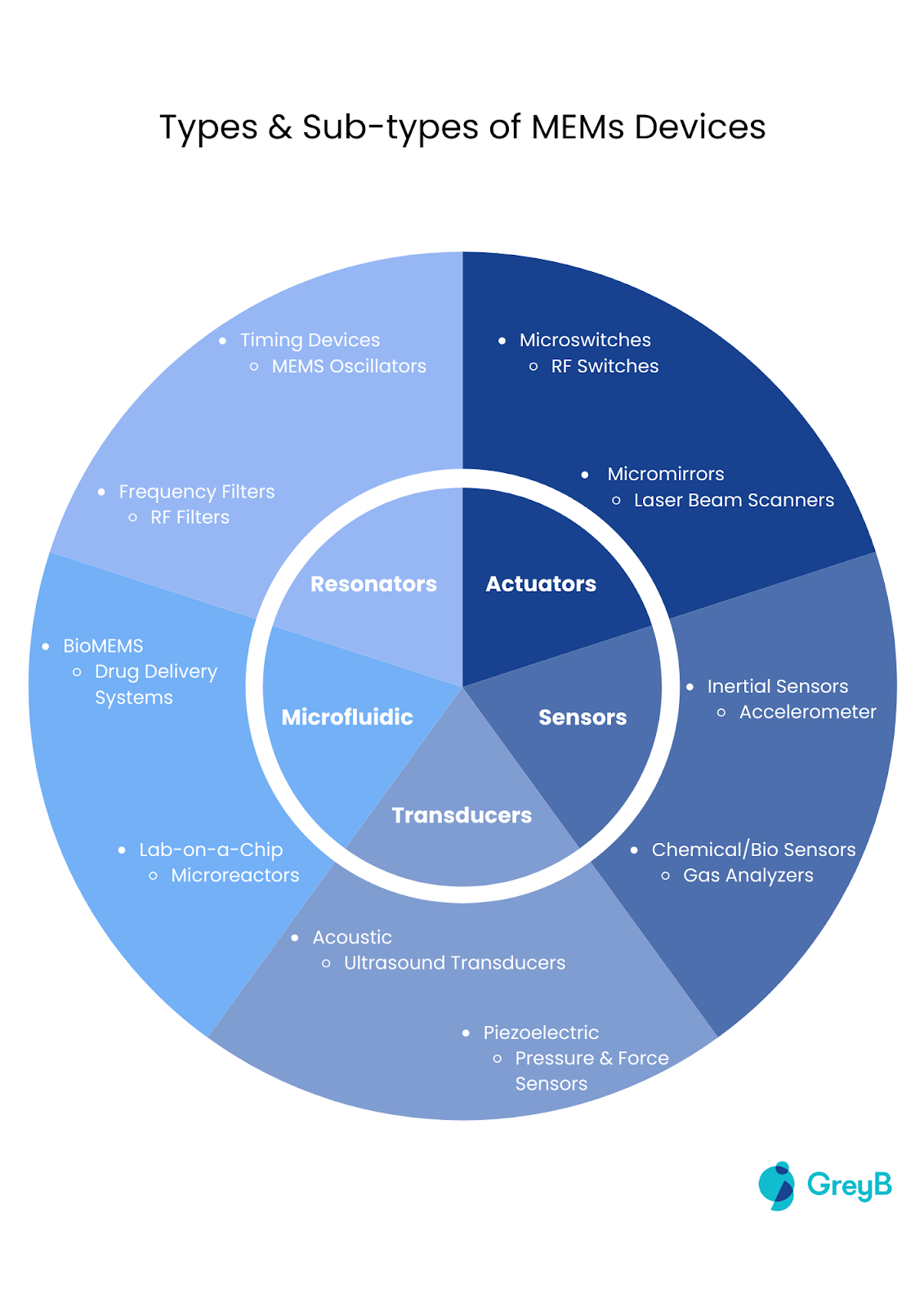
Impact of Industry Trends on MEMs
MEM technology is influenced by broader industry trends across the automotive, healthcare, telecommunications, consumer electronics, and aerospace sectors. The needs of these sectors dictate the demand and shape the technological direction and innovation for MEM Devices in miniaturization, power efficiency, and environmental sustainability.
Understanding the intersection of these trends is critical for anticipating how MEMs will adapt and grow in the coming years.
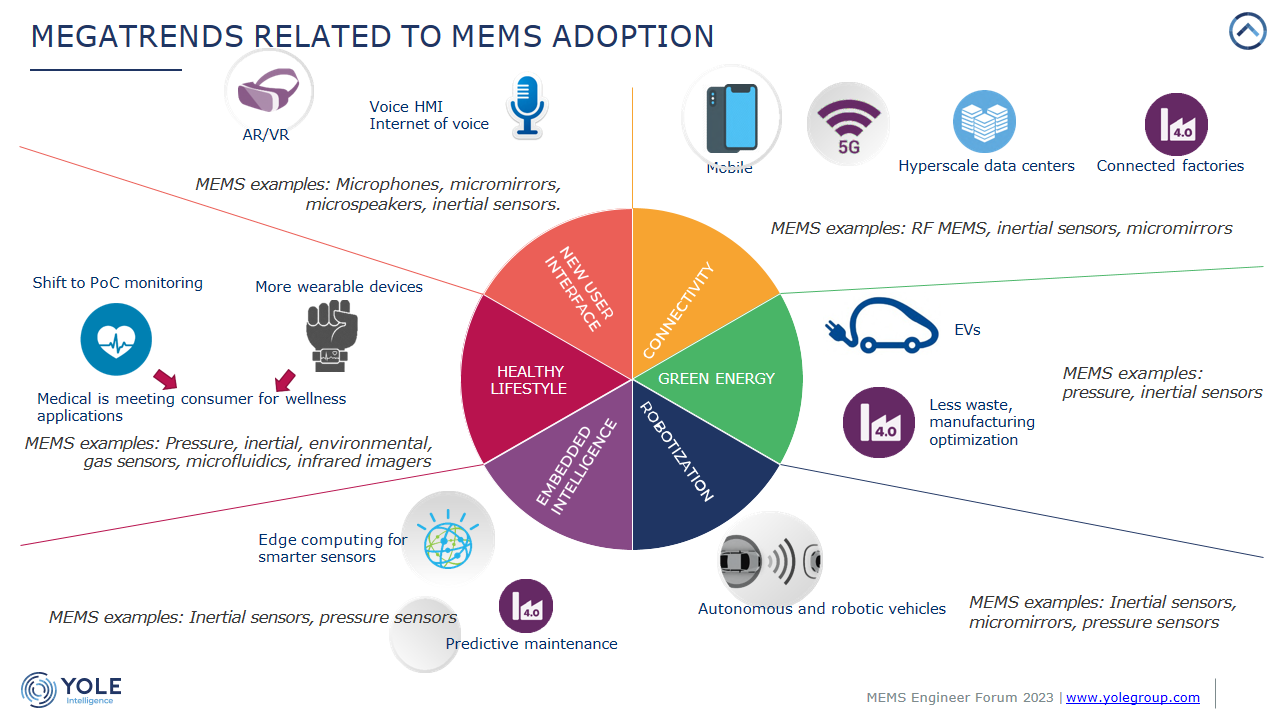
Automotive Industry
Over the past few years, significant MEM integration has been seen in autonomous vehicle development and electric vehicle (EV) platforms. MEMs-based LiDAR, accelerometers, and gyroscopes are critical enablers for real-time navigation, motion detection, and safety systems. As the push for autonomous driving intensifies, MEM sensors continue to evolve in terms of resolution, range, and environmental durability.
Healthcare and Diagnostics
MEMs-based lab-on-a-chip systems and implantable biosensors have seen increased adoption for remote patient monitoring. These devices enable real-time tracking of vital signs and diagnostics without bulky equipment.
5G and Telecommunications Expansion
The global rollout of 5G networks has catalyzed the demand for MEMs RF switches and oscillators that improve signal integrity and efficiency. MEM technology is essential to scaling up the capacity and speed of 5G infrastructure. Recent innovations are focused on making these MEM components smaller, faster, and more reliable to handle increased data traffic.
Consumer Electronics and Wearables
The development of MEM microphones, accelerometers, and pressure sensors for smartphones, VR headsets, and wearables has grown rapidly in the last few years. These devices are critical for features like voice control, gesture recognition, and health tracking in compact form factors.
Emerging Trends and Research Areas
Industry-specific needs and technological advancements like AI and AR/VR are reshaping the MEMs industry with distinct trends and research areas:
Integration with AI and Machine Learning
The fusion of MEM technology with AI/ML algorithms has been a focus area, especially in smart sensors and IoT devices. MEM sensors are increasingly capable of edge computing and can process data locally for faster, more efficient decision-making. This trend is seen in automotive for advanced driver-assistance systems (ADAS) and industrial automation applications.
Energy Harvesting and Low-Power Devices
With the growth of IoT and smart infrastructure, the demand for autonomous MEM devices with minimal power consumption has surged. Recent research is focused on energy-harvesting MEMs that can generate power from environmental sources such as vibration, heat, and light, reducing the need for batteries and extending device lifespans in remote or inaccessible areas.
Flexible and Stretchable MEMs
A growing interest in wearable technologies has led to advancements in flexible and stretchable MEMs devices. These devices, designed for biomedical applications such as continuous health monitoring, offer new opportunities for noninvasive diagnostics and remote care while improving user comfort and durability.
BioMEMs and Healthcare Innovations
The healthcare sector continues to be a strong driver of MEM innovation, with BioMEMs (biomedical MEMs) leading the charge in drug delivery systems, microfluidics, and real-time health monitoring. In the past year, there has been notable progress in implantable MEM devices for chronic disease management and advanced diagnostic tools for analyzing biological samples at a micro-scale in personalized medicine.
Market Landscape and Segmentation
Technology/Product Segments
The MEMs market is primarily segmented into sensors and actuators. The sensors segment is expected to grow most, particularly for inertial, pressure, and environmental sensors.
The application of MEM sensors in sectors like automotive, consumer electronics, and industrial automation drives this growth. Gyroscope sensors, used in automotive and aerospace, are poised for significant expansion due to increasing demand for navigation systems and drones.
RF MEMs, employed in 5G infrastructure and IoT devices, are also experiencing rapid growth, with a projected CAGR of over 11%.
Industry/End-User Segments
The consumer electronics segment dominates the MEMs market, holding nearly 40% market share in 2022. It continues to grow as IoT devices, wearables, and smartphones evolve.
In the future, MEM technology will see the most growth in the automotive sector due to increasing demand for MEM-based sensors in autonomous vehicles and electric cars. These devices are essential components for automotive safety systems like airbags, tire pressure monitoring, and vehicle stability control.
Geographical Regional Segments
Asia-Pacific is the largest and fastest-growing region in the MEMs market, driven by its dominance in consumer electronics and significant investments in healthcare and automotive industries.
Countries like China, Japan, and South Korea are at the forefront of this growth, supported by government initiatives, increasing demand for electric vehicles, and expanding 5G infrastructure.
North America is also a critical market, particularly in the aerospace, defense, and healthcare sectors.
Leading Companies in MEM
Top players in this industry are STMicroelectronics, Bosch Sensortec, Texas Instruments, Honeywell, Analog Devices, NXP Semiconductors, TDK Corporation, Qualcomm, InvenSense (now part of TDK), and Broadcom.
Here is a technology and innovation overview of one of these companies:
STMicroelectronics (ST)
STMicroelectronics is a leader in the MEMs industry, focusing on multiple high-growth areas, including automotive, industrial, and consumer electronics.
ST’s MEMs technology is heavily utilized across the automotive and industrial sectors as gyroscopes, accelerometers, and 6-axis inertial measurement units (IMUs). It is used for airbag deployment, electronic stability control, and telematics systems in the automotive industry.
The company’s innovative ThELMA60 technology utilizes a thicker epitaxial layer (60 microns) to improve the performance of high-end inertial sensors while maintaining cost efficiency in MEMs.

Source: STMicroelectronics
ST’s iNEMO IMU (Inertial Measurement Unit) technology is another key development in MEM. This IMU integrates motion sensors with an ultra-low-power processing circuit. It is a compact solution for wearables, portable devices, mobile handsets, and industrial positioning devices.
The company has pioneered the world’s first Lab-in-Fab in Singapore, a collaboration with A*STAR and ULVAC focused on developing Piezo MEMs technology. This R&D initiative aims to fast-track MEM solutions for AR, VR, medical devices, and 3D printing.
STMicroelectronics focuses on sustainability and energy efficiency, developing MEM sensors that align with smart mobility and green energy initiatives. Its strategy emphasizes embedding intelligence into MEM devices to reduce power consumption in IoT and smart devices.
In 2023, STMicroelectronics’ LIS2DUX12, an ultra-low-power accelerometer featuring integrated artificial intelligence (AI) and anti-aliasing capabilities, received the “Best of Sensors” award in the MEMS category at the Sensors Converge Conference and Expo.
This accolade recognizes the LIS2DUX12’s innovative design, which combines energy efficiency with advanced edge processing. This makes it suitable for applications such as wearable devices, game controllers, and IoT devices.
Interested in knowing other organizations’ activities in MEMs?
Submit your request here:
Investment Trends and Funding Activity
The MEMS industry players are getting financial support from governments and technology-driven sectors to grow and innovate.
Major investment and funding activities across the globe include:
- Silicon Microgravity received funding in July 2024 through the UK’s Defence Technology Exploitation Programme (DTEP). The funding is for a project to develop lightweight MEMS accelerometers for high-precision navigation in collaboration with Collins Aerospace. MOD’s Directorate of Industrial Strategy, Prosperity, and Exports (DISPE) backs this funding, delivered through the Defence and Security Accelerator (DASA), Innovate UK, and ADS.
- In July 2024, Rogue Valley Microdevices (RVM) signed a non-binding preliminary memorandum with the U.S. Department of Commerce to receive up to $6.7 million in funding through the CHIPS Act.
This funding will support the construction of a new MEMS and sensor foundry in Palm Bay, Florida. It will be the first MEMS facility in North America to produce 300mm wafers. The company is the first pureplay MEMS foundry to secure proposed funding under the CHIPS Act.
- In September 2023, Nanusens, a UK-based MEMS startup, initiated its Series A funding round to enhance product development and market reach for MEMS-integrated chips targeting consumer electronics and IoT devices. The company seeks to raise £10 million at a pre-money valuation of £40 million to advance its innovative MEMS technology.
- The Japanese semiconductor industry is fostering new synergies, attracting foreign companies and capital, and providing financial support to local enterprises for growth. Substantial investments and funds to the MEMS and semiconductor industries are allocated by the Japanese government, including:
- €6.25 billion to startup Rapidus (a consortium of Japanese companies in collaboration with IBM Research) to build its first factory in Chitose, Hokkaido, for two-nanometer chip technology. The factory is scheduled for 2026-2027.
€2 billion has already been allocated to this startup for production, and €1.8 billion for R&D. The total investment planned for this project is €18.7 billion, including a subsidy of €3.7 billion in April 2024.
- An additional €18.7 billion will be invested in TSMC’s new plant, and €125 million will be invested in Samsung’s R&D facilities in Japan.
- Powerchip is pursuing government support for a €5 billion foundry, while Micron announced a €3.1 billion investment.
These funding activities highlight robust financial backing for MEMS development, supported by private investments and government-led initiatives across key global markets.
Recent Acquisition Activities in MEMs
Acquisitions within the MEMS industry highlight companies’ strategic push to expand capabilities, integrate cutting-edge technologies, and strengthen market positions across key sectors like automotive, healthcare, and consumer electronics.
Syntiant Corp Acquisition of Knowles Corporation
In a strategic move to expand its edge AI capabilities, Syntiant Corp. announced a $150 million acquisition of Knowles Corporation’s Consumer MEMS Microphones (CMM) business on September 19, 2024.
Knowles’ CMM division, renowned for its SiSonicTM MEMS microphones used in voice and audio applications across various devices like smartphones, smart speakers, and wearables, will bolster Syntiant’s product offerings. This acquisition enables Syntiant to provide a comprehensive turnkey solution by integrating MEMS microphones with AI-driven hardware. It creates an advanced edge AI audio solution for voice commands, speech recognition, and audio event detection applications.
Syntiant will pay $150 million in cash and stock for the acquisition, funded by Structural Capital and Boardman Bay Capital Management.
Millar Announced to Acquire Sentron
On November 13, 2023, Millar, a longstanding leader in pressure sensor technology for medical devices, announced its strategic intent to acquire Sentron, a Netherlands-based manufacturer specializing in pressure and pH sensors. This acquisition will enable Millar to significantly broaden its product offerings, adding pH and electrical conductivity sensors to its portfolio.
The merger aligns with Millar’s mission to advance medical research and patient outcomes through innovative sensor solutions, positioning it as a comprehensive provider in the MEMS pressure sensor field. By integrating Sentron’s cleanroom facilities and manufacturing expertise, Millar aims to expand its global footprint and enhance distribution capabilities, establishing itself as a one-stop shop for sensor-enabled medical devices. Pending final legal review, Sentron will become a wholly-owned subsidiary of Millar by the end of 2023.
Safe Monitoring Group Acquired MEMS AG.
On June 12, 2024, Safe Monitoring Group AB, a leader in gas detection and analyzer manufacturing, completed the acquisition of MEMS AG, a Swiss-based company specializing in MEMS technology.
MEMS AG is known for its expertise in developing high-precision MEMS-based gas detection sensors and monitoring solutions. This acquisition will enhance Safe Monitoring Group’s capabilities to ensure safe and efficient gas use and advance renewable energy applications.
The integration will allow both companies to expand their range of products and services while facilitating collaboration in R&D, marketing, procurement, and customer service.
Recent Collaboration Activities
Collaboration and cross-industry partnerships are part of the MEMS industry as the technology is essential for diverse fields like automotive, healthcare, consumer electronics, and renewable energy. By joining forces, companies can combine specialized expertise, accelerate innovation, and address complex challenges more effectively.
SBQuantum and Silicon Microgravity Collaboration on Mining Exploration
SBQuantum and Silicon Microgravity have partnered to develop a drone-based sensor system that combines diamond quantum magnetometers and gravimetric sensors to enhance mineral exploration.
This collaboration, named the Quantum Accelerated Mining Exploration project (QUAMINEX), aims to accelerate the discovery of critical minerals like cobalt, lithium, and rare earths by providing high-resolution, 3D geological imaging, reducing exploration time and cost.
The project, partially funded by the governments of Canada (CAD 500,000) and the UK (£414,000), will be completed over 18 months. The technology’s deployment in Canada marks the first use of a diamond-based quantum magnetometer on a drone, offering up to 30% improved resolution over conventional methods and supporting the global energy transition.
TATA Group and Analog Devices
In September 2024, Tata Group and Analog Devices, Inc. (ADI) announced a strategic alliance to bolster India’s semiconductor ecosystem. Tata Electronics, Tata Motors, and Tejas Networks signed a Memorandum of Understanding with ADI to explore cooperative manufacturing opportunities and integrate ADI’s semiconductor products into Tata’s applications, including electric vehicles and network infrastructure.
Tata Electronics is investing $11 billion in India’s first semiconductor fabrication facility in Dholera, Gujarat, and an additional $3 billion in a greenfield facility in Jagiroad, Assam, for chip assembly and testing. The partnership seeks to leverage these facilities to produce ADI’s products, advancing technological innovation and sustainable growth in the region.
TDK Open Collaboration Initiative
In June 2024, TDK Corporation introduced the InvenSense Sensor Partner Program to accelerate innovation and reduce time-to-market for products utilizing InvenSense MEMS sensors.
This initiative aims to foster collaboration among original design manufacturers (ODMs), original equipment manufacturers (OEMs), developers, and engineers. It provides access to a diverse range of MEMS sensors, including motion sensors, industrial motion modules, microphones, pressure sensors, and ultrasonic sensors.
The program offers reference designs, software solutions, and development kits to facilitate efficient prototyping and development across various applications such as wearables, audio devices, healthcare devices, drones, and robotics. Renesas Electronics Corporation, Ambiq Micro, and Qualcomm Technologies are key partners in this program.
Analog Devices and Envision Energy Working Together for China’s Wind Energy
In March 2023, Analog Devices (ADI) announced a collaboration with Envision Energy to enhance the safety and reliability of smart wind turbines in China’s growing wind power market. This partnership leverages ADI’s expertise in MEMS technology to meet the demand for more resilient wind energy systems.
Envision will integrate ADI’s high-precision inertial measurement units (IMUs) and low-noise, low-drift accelerometers on critical components like tower barrels. This technology enables real-time, edge-based monitoring of vibration, tilt, and structural integrity to prevent extreme accidents, such as tower collapses, and to enable predictive maintenance.
Omnitron Partnership with Silex
In September 2023, Omnitron Sensors, a semiconductor startup manufacturing MEMS step-scanning mirrors, partnered with Silex Microsystems, the world’s largest MEMS foundry, to deliver high-volume, cost-effective products. The company aims to offer MEMS mirrors that meet sub-micron accuracy for LiDAR in automotive ADAS, robotic cars, and drones.
STMicroelectronics and OQmented Partnership
In March 2021, STMicroelectronics and OQmented announced a strategic partnership to co-develop, manufacture, and market advanced MEMS mirror-based laser beam scanning solutions.
This collaboration focuses on augmented reality (AR) and 3D sensing applications, aiming to deliver high-performance, compact, and energy-efficient systems.
STMicroelectronics contributes its extensive MEMS design and manufacturing expertise, while OQmented brings its patented Bubble MEMS® technology, which enhances performance through hermetic vacuum sealing of MEMS micro-mirrors. This partnership seeks to advance laser beam scanning technologies and expand their adoption in various markets.
Regulatory and Compliance Standards
MEM technology is significantly impacted by regulatory and compliance changes across crucial end-user industries such as automotive, healthcare, telecommunications, and aerospace.
In the automotive sector, Stricter safety regulations, such as ISO 26262, require higher precision and reliability from MEM sensors in ADAS and autonomous vehicles, driving sensor accuracy, and durability innovation.
In healthcare, updates in FDA guidelines and EU MDR regulations push for more rigorous testing and validation of MEMs-based medical devices, like biosensors and monitoring systems, ensuring they meet safety and efficacy standards.
Similarly, in telecommunications, the rollout of 5G has led to compliance requirements around signal integrity and power efficiency, which have influenced the design of MEMs RF switches and filters.
In addition to these industry-specific standards, global regulations and changes are also shaping the growth trajectory of the MEM industry. Have a look at these regulations and compliance standards below:
Environmental and sustainability regulations
Key regulations like the RoHS (Restriction of Hazardous Substances) and REACH (Registration, Evaluation, Authorisation and Restriction of Chemicals) in the European Union continue to enforce strict controls on hazardous materials like lead, mercury, cadmium, and other dangerous substances in electronics, including MEMs. These laws push MEM producers to innovate with greener materials and more sustainable production processes.
Additionally, the Clean Air Act and Clean Water Act in the U.S. demand stringent emissions and wastewater controls, influencing how MEM manufacturers manage their environmental impact.
In 2023, initiatives such as Intel’s commitment to 100% renewable electricity by 2030 and Onsemi’s net-zero emissions goal by 2040 highlight the industry’s broader shift towards sustainable semiconductor production. Major MEM players are improving energy efficiency and adopting closed-loop manufacturing to minimize waste.
CHIPS Act (U.S.)
The U.S. CHIPS and Science Act regulation includes incentives for domestic manufacturing, aiming to reduce supply chain vulnerabilities and increase production capacity. This increase in semiconductor fabrication will provide more opportunities for developing MEMs-based solutions, particularly in IoT and autonomous vehicles.
European Chips Act
The European Union’s Chips Act, passed in 2023, mobilizes over $46.7 billion in public and private investments to strengthen Europe’s semiconductor sector. It emphasizes the importance of advanced chip design and production for critical industries, which include MEMs for automotive and healthcare applications. This legislation is set to improve innovation and talent development in MEMs manufacturing across Europe, driving growth in MEMs integration into AI-driven and autonomous technologies.
Barriers to MEM’s Widespread Adoption
These barriers are slowing the widespread adoption of MEMs technology despite its growth potential across various industries:
Complex Manufacturing and High Costs
The production of MEM devices is highly complex, requiring advanced fabrication techniques and cleanroom facilities. This leads to high production costs compounded by testing and quality control costs. These expenses and expensive R&D for developing new components make it difficult for companies to achieve cost-efficient mass production.
Lack of Standardization
The lack of standardized fabrication processes in the MEMs industry is a significant hurdle to mass adoption. Each MEM device typically necessitates a unique design and production method, which hampers scalability. Moreover, the need for custom solutions when integrating MEM components with other systems poses a challenge for new entrants and existing companies looking to scale production.
Supply Chain Vulnerabilities
MEM production is susceptible to disruptions in the global supply chain, as witnessed during the COVID-19 pandemic. Shortages in essential materials and components have made it difficult for manufacturers to maintain consistent production levels, further limiting the growth of MEMs in certain sectors.
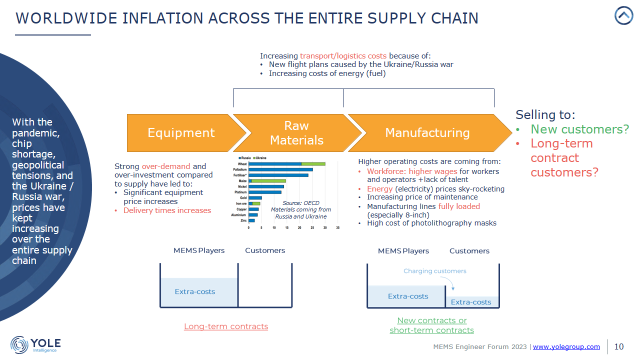
End-user Industries Challenges with MEMs
Buyers of MEMS (Micro-Electro-Mechanical Systems) face several challenges when sourcing these components from suppliers. Here are some of the key issues:
Supply Chain Reliability
Due to the precision and specialized nature of the manufacturing processes, MEMS production can be sensitive to disruptions. Disruptions can arise from material shortages, equipment failures, or geopolitical issues, leading to delays and increased buyer costs.
During the COVID-19 pandemic, disruptions in international logistics affected the availability of critical raw materials and components for MEMS manufacturing. This led to delays in producing MEMS sensors for automotive applications, causing a ripple effect that delayed the manufacture and release of new vehicle models.
Quality Variability
Consistency in product quality is a significant challenge. Variations in manufacturing conditions or process misalignments can lead to batch-to-batch variability, affecting the performance of the MEMS devices in the end products. This variability can impact the reliability of consumer electronics, automotive systems, or medical devices that depend on these sensors.
While industries have applied quality control strategies to overcome these challenges, those measures add to the cost and cause process delays. Some of these are enhanced Quality Control Measures like automated optical inspection (AOI) systems and Advanced Statistical Process Control (SPC) to identify trends that can cause quality disruptions.
Technological Mismatch
MEMS suppliers must continuously adapt and innovate as technologies advance in end-user industries. However, there can be a gap between suppliers’ available technology and buyers’ specific needs or specifications. This mismatch can limit the functionality of the end products or delay product launches while waiting for suitable components.
Cost Pressures
While MEMS technologies offer substantial benefits, they can also be expensive due to the complex manufacturing processes involved. Buyers are under constant pressure to match competitive prices and consumers’ expectations, which can be challenging with high supplier costs, production complexities, and low yields.
Fitbit, known for its wearable technology, is continuously under pressure to keep costs down while integrating advanced MEMS sensors to track steps, monitor heart rates, and more.
Integration Challenges
Integrating MEMS devices into existing systems can be technically challenging. Buyers must ensure that these components are compatible with other parts of their product, which requires precise engineering and can lead to additional R&D expenses and extended product development timelines.
Growth Opportunities
The MEMs (Micro-Electro-Mechanical Systems) industry is undergoing a major transformation driven by material innovations and cutting-edge technology advancements. These developments are unlocking new applications across end-user industries, providing manufacturers with many growth opportunities.
Event-Based or Zero-Power MEMs
Event-based or zero-power MEMs are designed to activate only in response to specific events, significantly reducing energy consumption. Research institutions like MIT and Stanford University are pioneering these innovations, while companies like Bosch and SiTime are working on ultra-low-power sensors for IoT.
These MEMs result from the need for energy-efficient, long-lasting sensors, particularly in IoT and environmental monitoring. These technologies are poised to be key in creating low-power networks for smart cities and remote sensing applications.
MEMs Energy Harvesting Technologies
Energy harvesting MEMs aim to create self-powered systems that capture ambient energy from vibrations, light, or heat. Georgia Tech and EPFL are leading research, with STMicroelectronics and EnOcean commercializing energy harvesting for industrial IoT and wearables.
These technologies are critical for autonomous, battery-free devices, reducing the need for frequent battery replacements. Wearable technology, smart infrastructure, and remote monitoring systems, where self-powered, low-maintenance sensors are drivers behind this innovation.
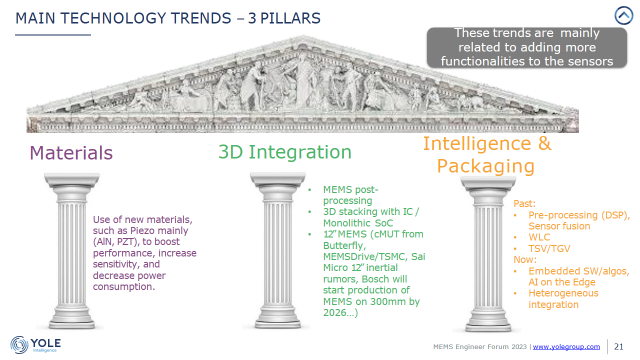
AI-Enhanced MEMs
AI-enhanced MEMs incorporate machine learning algorithms for on-device data processing, reducing latency and improving energy efficiency.
Researchers at UC Berkeley and Stanford are leading AI integration efforts, with companies like STMicroelectronics developing AI-enabled MEMs for real-time applications. These innovations are essential in autonomous vehicles, industrial automation, and healthcare, where real-time decision-making is critical.
The demand for AI-enhanced MEMs comes from industries requiring fast, intelligent data processing, enabling advanced analytics without relying heavily on cloud computing.
Innovation in MEMs Materials
New materials such as silicon carbide (SiC) and gallium nitride (GaN) are gaining popularity due to their enhanced thermal and chemical resistance, making them ideal for harsh environments.
Bosch is a leader in MEMs manufacturing, producing over 10 million MEMs sensors daily as of 2023. Bosch has recently invested in new materials research, particularly in SiC MEMs, which are used in electric vehicles (EVs) to enhance battery performance and thermal management.
SiC-based MEM devices are used in automotive applications where extreme temperature and pressure conditions require superior durability. The SiC MEMs market is projected to grow at a CAGR of 15% by 2028, particularly in sectors like automotive and aerospace.
Another key development is flexible MEMs made from polymer-based materials. These are becoming crucial in healthcare, where wearables and biomedical devices demand flexibility for patient comfort.
Research published in Nature Electronics in 2022 highlighted a flexible MEM sensor designed for real-time blood pressure monitoring, providing a breakthrough in non-invasive healthcare technologies. This innovation is expected to grow the biomedical MEMs market by 12% CAGR by 2030
Organic MEMs
Organic MEM devices, made from organic semiconductors and polymers, are becoming increasingly important due to their low cost of production and biodegradability. They are particularly suited for disposable healthcare devices, where cost and sustainability are critical.
A recent study published in IEEE Sensors Journal reported successfully developing an organic MEM pressure sensor designed for disposable medical applications like insulin pumps and drug delivery systems. As adoption increases, the healthcare sector’s organic MEMs market is expected to grow 8-10% annually.
Technology Innovation in MEM
Introducing 3D MEMs has allowed for more complex sensor designs, improving performance across sectors. Companies such as Bosch and STMicroelectronics are leading the charge in integrating 3D MEMs into autonomous driving and aerospace navigation systems. The 3D MEMs market is projected to reach $3.4 billion by 2027, fueled by these developments.
Integrating nanotechnology into MEM devices, known as nano-MEMs or NEMs, creates ultra-sensitive sensors with applications in drug delivery, molecular diagnostics, and environmental monitoring.
Researchers at the University of California, Berkeley, recently developed nano-MEMs for detecting biomarkers in cancer patients. This technology enables early-stage diagnosis and is expected to contribute to a 20% increase in the use of MEMs in healthcare diagnostics by 2028.
Next Steps
MEMS technology accelerates advancements across automotive, healthcare, consumer electronics, and telecommunications, driven by AI integration, energy-efficient designs, and breakthroughs in wearable and bioMEMS applications.
As demand grows for compact, high-performance sensors and actuators, strategic investment, cross-industry innovation, and collaboration become critical to addressing manufacturing and supply chain complexities.
For companies, investors, and innovators, MEMs represent a rapidly evolving landscape with vast potential for growth and impact.
For detailed insights into specific technical areas, emerging trends, or industry applications, contact our experts to request a customized technical analysis tailored to your strategic goals!
Authored by: Naveen Kumar, Marketing, and Mayank Maloo, Solutions.










